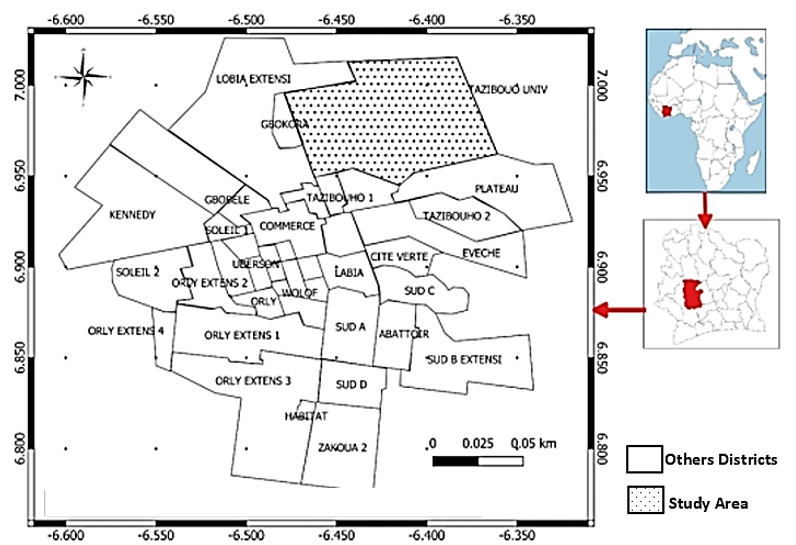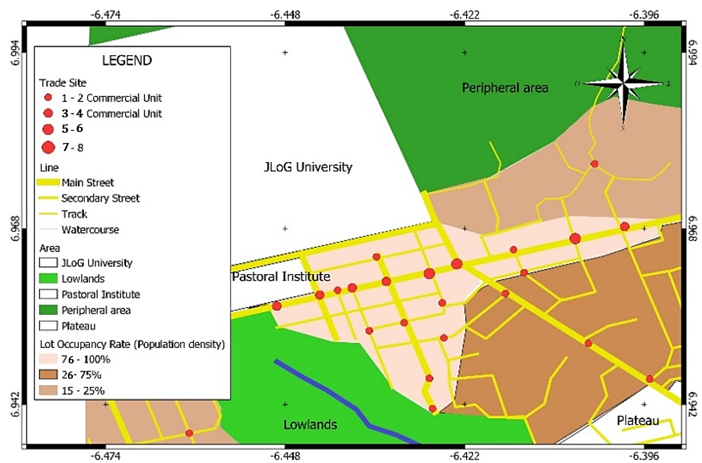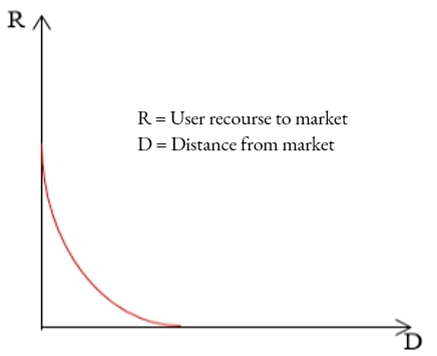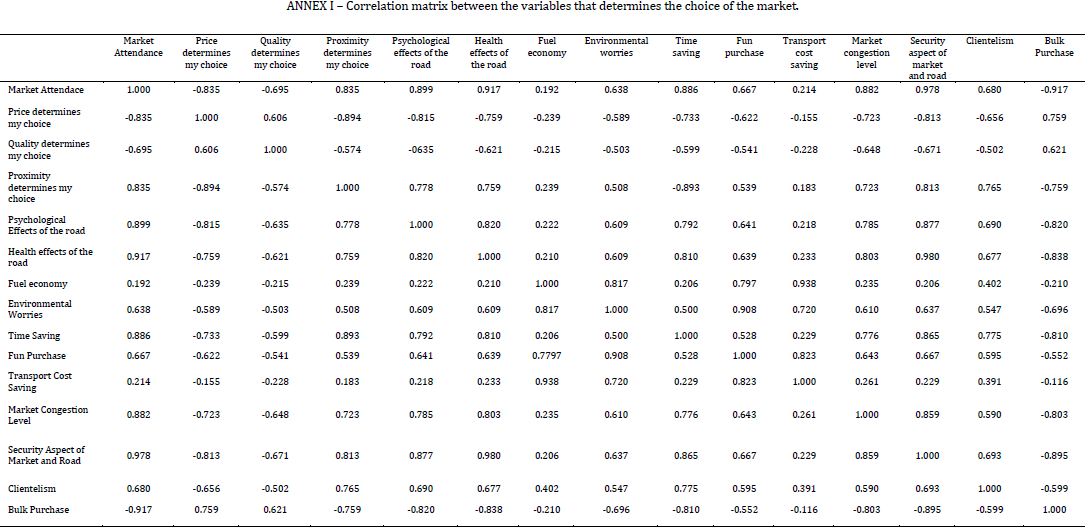I. Introduction
Côte d'Ivoire is a West African country and the economic powerhouse of the West African Economic and Monetary Union (WAEMU). In this country, markets account for most of the activity and dynamism of the urban informal trade sector. This happens because they supply almost the entire urban population with manufactured goods, foodstuffs, and basic goods such as rice, sugar, flour, etc.
The polysemous term "market" is used here in the sense of a physical place of exchange with an undeniable socio-economic function. Since the early 1970s, markets in Côte d'Ivoire have ceased to be simple halls (Wilhelm, 1997, p. VIII), communal markets in Côte d'Ivoire have tended to expand in terms of the range of services and goods on offer, their spatial scope and the infrastructural amenities provided. Nowadays, they are equipped with stores and stalls, and even health centers, banks, and Information and Communication Technology (ICT) services.
Every major city in the country has "central" markets that are relayed by small neighborhood markets, and the city of Daloa is part of this reality. Daloa is both a crossroads town and a market town with some forty neighborhoods, including Tazibouho, which comprises several sectors: Tazibouho 1, Tazibouho 2 and Tazibouho-Université. Tazibouho-Université is a residential district whose market has a particular spatial configuration that contradicts the general aspects of markets in Black Africa, where they are arranged in a tightly woven pattern, constituting an essential element of the territorial network (Chaléard, 2002, p. 114).
In this, Santos (1975, p. 19) considers that markets are a subsystem of the general system of spatial relationships of which the city is one of the centers or one of the elements. In practical terms, the market in Africa refers to the place where producers (merchants, artisans, farmers) gather to offer their products directly to consumers (Bontems & Calmette, 2019, p. 3). The Tazibouho-Université market is not a single place, but a discontinuous and diffuse spatial entity.
This geographical configuration of the market and its area of influence certainly obey to economic principles. As a result, their network of relationships is atypical in its individualized character, which refutes the aspect of traditional African markets. And yet, these markets are thriving. At first glance, this brings us back to the notion of convenience in its commercial sense, insofar as it links commercial facts and cultural implications by being a symbol of individual freedom. This terminology, which is the sign of an American lifestyle, is originally synonymous with proximity (Claire & Chanut, 2012), or even banality, manifest characteristics of Tazibouho Université's fragmented market.
What's more, the sentimentality that overhangs the commercial ambience here gives way to an interactionist approach through a relational process integrating both a frame and a self (Abdelfettah, 2020, p. 3). This gives added value to the functional health of this atypical market, which does not need to be explained by conventional truths.
At this stage of our thinking, the path needed to build a complete analysis of this commercial peculiarity, leads to the enlargement of this local economic landscape, on the scale of new distribution modes around the world. So, it would be scientifically wise to analyze the economic mechanisms that influence individual decisions, which in turn determine the different locations of business units in the Tazibouho-Université district.
To explain the ideas, in addition to this introduction, the article comprises four more sections. The first presents the conceptual framework that explains the spatial distribution of outlets, the spatiality of economic agents and the motivations behind these journeys. The second section describes the methodology used in the research. The characteristics of the study area are briefly presented, as well as the methods and techniques used to collect and process the information. The third section analyzes the results of the empirical research, first in a descriptive way and then focusing on the myriad factors responsible for the growth of the Tazibouho-Université market. The fourth section discusses the results by comparing the empirical work with the theory defended in the scientific literature. Finally, the article closes with a brief conclusion on our hypothesis that guided the research.
II. Conceptual framework
This study, which describes and explains the spatial distribution of commercial facilities, the spatial movements of economic agents towards these premises and the motivations behind these movements, all justify the choice of neoclassical theory with its microeconomic foundations. Neoclassical theory promotes interdisciplinarity between geography and economics and enables more cross-disciplinary results to be achieved. A priori, it provides answers to the study's initial questions in a hypothetico-deductive approach. In particular, it emphasizes that the market is the most efficient way of allocating resources and coordinating individual actions.
What makes this theory so interesting is the importance it attaches to the notion of the market. Regarding markets, Jean Baptiste Say (1803) points out that supply creates its own demand, so there's no reason to hoard. This is supported by the Walrasian equilibrium, which marks the quantitative match between supply and demand in a market or economy. It explains how the level of production and consumption of goods, and prices, are determined. A market is in equilibrium when supply and demand equalize, at the end of a process in which price movements gradually absorb excess supply or demand. More specifically, it seeks to simultaneously determine the quantities traded and the prices that equalize supply and demand for these quantities.
The aim is to understand how a multitude of agents can trade many goods on markets under conditions of Pure and Perfect Competition (PPC). The answer to this question is that Walrasian equilibrium is achieved interdependently on the markets for goods and services, production, and money. Each individual, through his or her egoism and desire to maximize profit or satisfaction, converges towards this ideal, thus defining homo economicus as a rational individual, a theoretical representation of human behavior.
This theory also indexes the notions of personal will and satisfaction, which led us to develop the notions of perceptions of the various agents surveyed. In this same current, the notion of time appears through the inter-temporal equilibrium with rational anticipations of Lucas (1972). He thus introduces the future, and consequently anticipation, which is considered here as a forecast formed by rational economic agents who anticipate whether the price rise will be permanent or temporary.
As for the value of goods, there are two opposing theories: on the one hand, the value-utility theory accepted by Say (1803) and Mill (1808), who consider that the value of a good lies in the utility it provides. And on the other hand, the labor-value theory accepted by Smith (1776) and Ricardo (1817), which considers that the value of a good depends on the amount of labor required to produce it. But there is still confusion between the use value and the exchange value of a good.
Faced with this difficulty, Walras (1874) presents utility as a necessary but not sufficient condition for defining value, while labor is only worth its scarcity. In contrast to the English supply-side theory of value, the Neoclassicals favored a demand-side approach. Exchange value is determined at the point of exchange by the confrontation of supply and demand. This appreciation led us to analyze the price contingencies of the Tazibouho-Université market empirically, by visiting the various business units.
Marshall (1890) synthesizes the two theories, arguing that they are not incompatible, since the Classics considered value from a supply-side perspective, while the Neo-Classics considered it from a demand-side perspective. On this basis, they show that in the short term, it is essentially demand conditions that influence the price of a good, while in the long term, the cost of production is the determining factor in the measurement of value. The neoclassical prerequisites therefore analyze so many indicators that have put us on the right track for completing this study.
III. Methodology
1. Study area
Daloa is the fourth largest city in Côte d'Ivoire, with an estimated population of 421 879 (Recencement Général de la Population et de l’Habitat [RGPH], 2021), after Korhogo, Bouaké and Abidjan, which has a population of nearly six million. It is the capital of the Haut-Sassandra region. This crossroads town includes the Tazibouho district in its northeast part, which comprises several sectors: Tazibouho 1, Tazibouho 2 and, above all, Tazibouho-Université, a residential district (fig. 1).
2. Data collection and processing techniques
Our investigations were carried out in two main phases. The first is part of an exhaustive study given the relatively small size of the space and the population surveyed, which allowed a census. The reason for this first phase is due to the total lack of information about our target population and its aim is to provide information on the number and typology of commercial units and actors. We counted the number of commercial units in this district by sight. This count enabled us to know exhaustively the number of actors involved in this type of business. It was carried out three times on three different days, to avoid errors due to the absence of shopkeepers. These were a Monday (January 10, 2022), the first working day of the week; a Thursday (January 13, 2022) in the middle of the week; and a Sunday (January 16, 2022), which was a non-working day. Thus, a total of 112 commercial units were registered with a margin of error of 11 units which concerns irregular units or units likely to be closed.
The results of this first phase allowed the beginning of the second through a sampling survey. Given that the shopkeepers observed in the Tazibouho-Université district constitute a composite group stratified according to the scale of their respective activities, purposive sampling enabled us to interview three shopkeepers, two traders on tarpaulins and ten traders on stalls, as the count shows that the latter are the most numerous. We conducted a semi-directive interview with these 15 traders. This enabled us to find out about the practical and financial realities of this market, in particular their sales figures, procurement procedures and customer loyalty techniques. In addition, a comparative study was carried out with other markets in the city. The criteria used to select the markets for comparison were their proximity to the Tazibouho-Université district and their reputation in terms of exceptional prices. These markets are the Gbokora and Lobia markets, chosen for their proximity to the district; the central market, for its central importance in the city; and the Balouzon market, held weekly on Tuesdays, for its reputation for generous prices. The test products covered by this comparative study relate to basic consumption in the locality and are therefore likely to be highly prized in all these marketplaces.
A questionnaire was administered to a series of 60 residents encountered by chance while shopping or in the vicinity of commercial units in the market that had been broken up as a result of accidental sampling. They were asked to give their opinions on how often they frequented the various shops and the reasons behind their choices. The questionnaire was inspired by Osgood's et al. (1957) verbal or semantic scale, or more precisely, the semantic differential, which ideally requires seven or five scales of appreciation. But the number of scales to be used is guided by common sense and the constraints of the study (Pinson, 1983, pp. 14-15). In the case of our study, we chose four values, considering the cognitive capacities of the respondents and their levels of vigilance regarding the relatively low level of illiteracy in this district. To do this, a series of fifteen variables were proposed to them, with single-choice questions between four modalities on a scale of values from 1 to 4, as in an opinion survey.
These modalities are as follows: 1 - variable very decisive in my choice, 2 - variable fairly decisive, 3 - variable not very decisive in my choice and 4 - variable not decisive in my choice. In this way, the most decisive variables were ranked in order of importance according to their respective percentages. This enabled us to carry out a univariate analysis, using the frequency of each modality per variable. These respondents were asked to justify their choices, and their justifications led us to flesh out the descriptive statistics of the results obtained.
The data were processed using Principal Component Analysis (PCA), the backbone of our analytical approach. Its principle is to summarize the information contained in a large database into a few synthetic variables called Principal Components. It enables us to summarize information by reducing the number of variables. It is a method of the data analysis family and, more generally, of multivariate statistics.
The variables used in this study are quantitative and ordinal qualitative, which are suitable for PCA (table 1). In addition, the type of treatment we have chosen, which consists in assigning a number to each modality chosen by the individuals (semantic differential), also allows us to perform a PCA.
Table 1 List of variables used in the study.
| COST VARIABLES | AFFECTIVE EFFECT VARIABLES | RISK VARIABLES | DISTANCE VARIABLES |
|---|---|---|---|
| - Freight prices - Fuel savings - Transport cost savings | - Level of customer loyalty - Number of leisure purchases - Quality of merchandise - Tazibouho-U. market footfall | - Market footprint - Environmental friendliness | - Time saving - Proximity - Sanitary level of distance - Safety level of the journey - Psychological level of distance - Number of visits to Tazibouho-U. market |
IV. Results
In the fragmented market of Tazibouho-Université, micro-activity is the generalized form of trade, and incomes are very low. Merchants are engaged in subsistence activities, and the notion of accumulation is not a major objective for them. The three forms of study carried out on this market - descriptive, statistical, and analytical - offer results that complement the postulates on markets.
1. Descriptive study of the Tazibouho-Université fragmented market
1.1.1 Differentiated precariousness of business units in the Tazibouho-Université fragmented market
The general appearance of the Tazibouho-Université market shows a precariousness that differs according to the social level of its players. The business units of Tazibouho-Université market are very small in size and sparsely distributed. Each market has a maximum of seven sellers, all of whom are women from different social backgrounds. They are widows or single women, wives of farmers and workers, and often even wives of middle-ranking government officials.
Their different social levels influence the scale of their businesses and the equipment they use to run them. For example, the less affluent women use makeshift stalls, or tarpaulins laid out on the ground along public roadsides. They generally sell foodstuffs accompanied by broths, and a few rare ladies sell fish or smoked or unsmoked veal chops.
On the other hand, the more affluent use shelves, metal containers or well-appointed premises. These premises are either rooms in their own concessions or stores rented from private individuals, where they sell foodstuffs and frozen products, showing that these outlets are electrified and equipped with freezers (fig. 2).
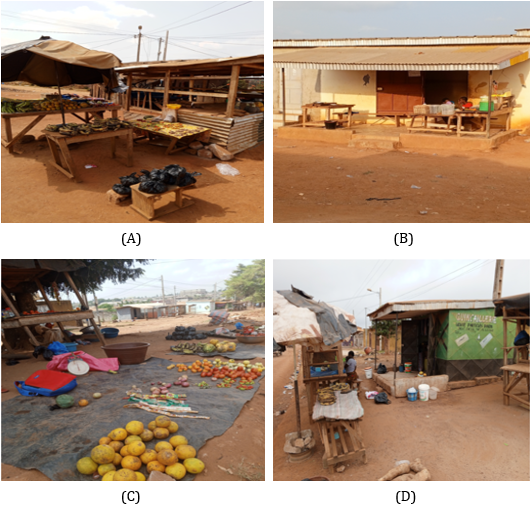
Fig. 2 Aspect of the Tazibouho-Université market units: A - Commercial Unit using tables and stalls; B - Commercial Unit brick and mortar stores; C - Commercial Unit using tarpaulin on the ground; D - Commercial Unit using metal conteners.
1.1.2 A relatively more expensive market
The Tazibouho-Université market is relatively more expensive than other communal markets in the city of Daloa. This is evidenced by a comparison of the prices of certain high-consumption commodities at selected markets, chosen based on their proximity to the Tazibouho-Université district and their location within the city (table 2).
Table 2 Comparative commodity prices at the Tazibouho-Université market and its neighbors.
| Tazibouho-U. bursting market | Balouzon market | Lobia market | Central market | Gbokora market | |
|---|---|---|---|---|---|
| Peppers | 4 at 100f | 10 at 100f | 6 at 100f | 6 at 100f | 6 at 100f |
| Eggplant | 5 at 100f | 10 at 100f | 7 at 100f | 7 at 100f | 7 at 100f |
| Orange | 5 at 200f | 10 at 200f | 6 or 8 at 200f | 6 or 8 at 200f | 6 or 8 at 200f |
| Industrial oil | 1L at 700 or 800f | 1L at 700 or 800f | 1L at 700 or 800f | 1L at 700 or 800f | 1L at 700 or 800f |
| Red oil | 0,5L at 800 f | 0,5L at 600f | 0,5L at 600f | 0,5L at 600f | 0,5L at 600f |
| Smoked fish | 1Kg at 2000f | 1 Kg at 1400f | 1 Kg at 1500f | 1 Kg at 1500f | 1 Kg at 1500f |
| Fresh fish | 1Kg at 1200f | 1 Kg at 1200f | 1 Kg at 1200f | 1 Kg at 1200f | 1 Kg at 1200f |
| Frozen veal chop | 1Kg at 1200f | 1 Kg at 1200f | 1 Kg at 1200f | 1 Kg at 1200f | 1 Kg at 1200f |
| Smoked veal chop | 2000f | 1400f | 1500f | 1500f | 1500f |
NB: 1€=654,56 Franc CFA
Regarding the prices charged, two specific product categories can be clearly distinguished in market activity:
The category of industrially processed products, made up of industrial oils, seasoning broths and unprocessed frozen products (fish and meat), which are uniformly priced on Daloa's markets thanks to an approval policy encouraged and followed by the State. The same applies to imported staples such as rice, sugar, and wheat flour. However, small deviations have been observed among some rogue traders who override government injunctions.
On the other hand, price quotations for local produce, whether foodstuffs, livestock or oilseeds, or processed products such as meat or smoked fish, vary widely, and are the most expensive market is Tazibouho-Université. However, despite its relatively high price, this market is still frequented by residents. Price, which is an essential element of neoclassical theory, is not a priority for economic agents in Tazibouho-Université
1.1.3 A market supplied with products of ordinary quality
One might think that the appeal of the Tazibouho-Université market to local residents, despite its relatively high price, is justified by the exceptional quality of its goods. However, the quality of the products found in these marketplaces is similar to that found in the city's other markets. These products come from the same origins, and the vendors buy from the same wholesale markets. Only a very small quantity comes from the surrounding fields through itinerant sellers. While this small share of produce has the advantage of being fresh, it is of the same quality as the other products, since cultivation techniques and soil specificities remain the same in the region.
It therefore follows that the choice of Tazibouho-Université residents for goods from this market is not dictated by its exceptional quality. It should be noted that this market is satisfactory for residents, who find most of their needs here, as it complements the frozen-meat sellers and Moorish stores. And even the presence of a supermarket, which is a formal trading structure not located in the downtown shopping district.
A descriptive study of the Tazibouho-Université market reveals that it is a market of precarious commercial units, charging high prices for products of ordinary quality. So, what is it that attracts residents to this market? In other words, what are the reasons for this market's dynamics?
2. Multifaceted factors in the growth of the Tazibouho-Université market
Several factors influence the choice of the Tazibouho-Université market by its local residents, over and above the key factors imposed by neoclassical market theory, namely price and quantity. These other factors concern distance and its impact on safety, psychology and health, the entertainment value of shopping, time savings, transport costs, and the level of clientelism between the various economic agents.
These factors were ranked according to different orders of importance among Tazibouho-Université residents. Descriptive statistics on the choices made by respondents show that 90% of them frequent the Tazibouho-Université market, and for certain variables, the frequency of the "very determinant" modality is over 75%.
In order of ranking, these variables are time saving and the safety aspect of the market and the journey, with a frequency of 88.3%, and the level of market congestion (85%). There are also variables of lesser importance: clientelism, which is a very determining factor for 63.3% of respondents. Transport cost savings and environmental concerns, fuel savings and leisure purchases were expressed by 26.7%, 25% and 28.3% of respondents, respectively.
On the other hand, only 13.5% said that the variables "price" and "quality" were decisive in their choice of markets. It is therefore clear that the first category of variables, which determines the choice of 90% of our respondents, is a key factor in our analytical approach.
Hence, both axes 1 and 2 from the PCA have, respectively, 66.79% and 16.62% of the expressed variance. Cumulated, both axes express 83,41% of this variance. This means that more than 83% of the information is therefore held by these axes. This distinction emerges clearly in the factor map after rotating the data (fig. 3).
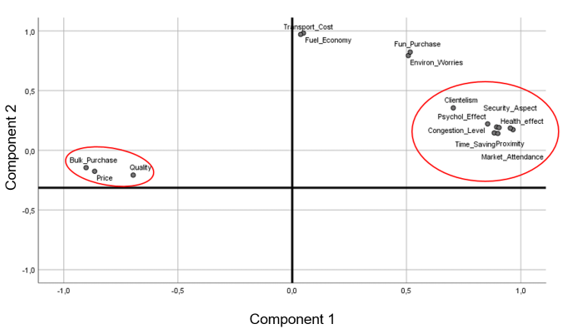
Fig. 3 Factor map of market choice indicators for local residents of Tazibouho-Université district, after rotation.
Rotation of the data by software contrasts two major consumer categories that are strongly and inversely correlated, with a contingency degree of -0.867: those who are attached to price versus those who are attached to proximity. On the one hand, those who prioritize price (least expensive) represent only 10% of consumers. On the other hand, we have those who prioritize proximity (90%). Each of these categories is interdependent with other variables that further reinforce the respective choices of local residents (Annex I).
The price variable is strongly correlated with the quantity of goods purchased, with a degree of contingency of 0.759. Consumers looking for cheaper products are obliged to buy from distant markets, notably Balouzon. There, they stock up for the month in bulk to offset the high frequency of the long journey. In doing so, they travel only once a month, so the frequency of the long trip is minimized at best.
The proximity variable is correlated with a larger number of variables that tend to cancel out the detrimental effects of distance. It is strongly correlated with the level of road-related health effects, with a correlation coefficient of 0.759, and with psychological effects (0.778). Thus, the desire to avoid the health, safety and psychological inconveniences associated with long-distance travel leads to a strong interdependence with frequentation of the proximal Tazibouho-Université market, with a correlation coefficient of over 0.9. The frequentation of this market generates a time saving which is a key factor in the users' decision-making process, justifying the strong positive correlation of 0.886 between these two variables.
2.1.1 The time and eco-healthy distance factor, essential capital for the development of local markets
The time factor in animating markets in Daloa is related to distance, but also to the realities of popular transport, which in turn is influenced by road conditions. Thus, the most distant markets will have a longer access time. This time is not controllable a priori, as the difficult accessibility of the Tazibouho-Université district due to the degraded state of its roads leads many cab drivers to avoid it. At certain times of the day, waiting times are abnormally long. As a result, users are turning away from distant markets in favor of the small commercial units of Tazibouho-Université. It's not an unconscious dislike on the part of these customers, who assess the monetary value of the time saved (Boiteux, 2001; Kanaté, 2020), and the resulting benefits such as increased safety and comfort.
Assuming that the cost of transport is infinitesimal, a local resident with an hourly wage of 10 000 fcfa (national coin) has a choice between the Tazibouho-Université market for a purchase that would cost him 5 000 fcfa and another market where the same purchase would cost him 3 000 fcfa. A first calculation allows us to deduce that the distant market is more profitable for him, as he saves 2 000 fcfa by frequenting it. But if he must waste an hour of time in his purchasing process, he has saved 2 000 fcfa in real terms, but has lost 10 000 fcfa in fictitious terms. This loss manifests itself directly in terms of money, or indirectly through fatigue and discomfort. It is therefore in his interest to buy supplies nearby, which is not the case for someone else who earns 1 000 fcfa an hour. The monetary value of time is therefore relative to the social status of the individual. As the residents of Tazibouho-Université are high-profile citizens whose estimation of the monetary value of time is respectable, they prefer to buy locally. After all, time is a scarce resource that must be allocated to the most useful activities if it is to be optimized.
What's more, Tazibouho-Université traders open very early in the morning, from 6 a.m., and close very late in the evening, until 9 p.m. in some cases. This shift is longer than that of communal markets, which open practically at 8 a.m. and close at 6 p.m. This time span is favorable to the working hours of residents, who can buy their supplies before leaving for work or on their return. Time savings are therefore a factor in decision-making and choices. This time saving comes from the reduction in distance, but also from the reduction in the number of exits for the long journey. In both cases, we can see the importance of the journey and the time it takes to make a choice, based on frequency or distance.
The optimization of time is materialized by the reduction of distances and the speed of supply. Retailers are mainly located on the main thoroughfare of the neighborhood, with more significant groupings at the various entrances and crossroads. This is a well-thought-out distribution insofar as each grouping resembles an islet or a group of islets. In this way, as the district evolves spatially and its population grows, so do its units (fig. 4).
At the main road and major crossroads, which are the most densely populated areas, we can see that the concentration of business units is higher; the clientele is made up on average of four blocks for a grouping of two to five shopkeepers. This means that time savings due to proximity, exemption from transport difficulties and longer opening hours are all beneficial factors for the frequentation of the Tazibouho-Université market. This high concentration in the densest areas considerably reduces queues. As the district expands, merchants move closer and closer to their customers, further reducing the distance and time taken to supply them, since beyond a certain distance, they do not frequent the market (fig. 5).
In a regulatory context where prices are approved and differences linked to the exotic nature of certain products are minimal, households turn to the market within a reasonable distance. From a critical distance onwards, the customer no longer frequents this shopkeeper either for the affections woven or for the favors he enjoys; he will henceforth be part of the goodwill for this shopkeeper and will often frequent her on a passing basis or for the exceptional nature of certain products. The trend towards minimizing distance, which is justified by safety, health, and psychological reasons, reinforces customers' attachment to the notion of eco-healthy distance in this district.
2.1.2 Building customer loyalty through affective proximity
Affective proximity arises from two mechanisms, both inherent to family contributions. It manifests itself in the role played by each family member in attracting a circle of friends or acquaintances. The family contribution is therefore important, as each family member urges his or her acquaintances to shop at the family micro-business.
Also, in some cases, the clientele is constituted by family inheritance, as the daughter who embraces the business benefits from her mother's former customers. The contribution of each family member to obtaining and retaining customers creates an affective closeness among the latter, manifested in the special ties that customers have with the various members of the shopkeeper's family.
These links are often strengthened by life-saving chats from which clients benefit because provided with information on the dangerousness of the neighborhood due to the presence of some individuals said to be dangerous. These local purchases are certainly for convenience but they are reinforced by an informational and saving nature which allows customers to know where to set foot in the neighborhood.
2.1.3 Taking psychological, health and safety parameters into account when making choices
With the ups and downs of the journey, the associated fatigue and some bad experiences of accidents or assaults, some users minimize the risks by shortening distances as much as possible. They prefer to buy close to home, to avoid the risk of being mugged, involved in a traffic accident, or even witnessing one. According to some, this protects them from any form of trauma, especially psychological. So, frequenting these local commercial units is also dictated by the desire for mental and physical health.
Still about health, some people avoid going far because of the dusty state of the road, which could cause illnesses such as coughs and colds, so it's easy to understand the strong correlation of 0.767 between these variables and proximity. For this group of respondents, the immediate cost of goods is certainly more expensive, but in the long run it is more advantageous, as it protects them from certain mental and metabolic illnesses whose treatment and consequences would be costly.
What's more, the small proportion of users who buy from distant markets for low-price reasons keep their shopping to a minimum, making monthly or fortnightly bulk purchases.
V. Discussion
According to neoclassical theory (Micaleff, 1982 apudAurier, 1990), in a competitive market, prices are the variable that determines the quantities offered or demanded by the different segments. Prices are the variable par excellence that coordinates production and consumption. The reasoning is that if supply is abundant, competition between suppliers leads to lower prices. If supply is insufficient, competition between buyers leads to higher prices.
At Tazibouho-Université district, however, the reality is quite different. It's distance that determines the behavior and choices of economic agents (consumers and suppliers). In practice, an increase in supply or even demand in this area leads to the break-up of commercial units, which move ever closer to new populated areas, and therefore to new customers. This process keeps prices constant and fosters sentimental relationships between suppliers and customers.
Distance has been highlighted in other studies, notably that of Moran (1966, p. 37-39), who states: "Location theories start from the consideration of the distances separating points in the economic space that are brought into relation with each other through a productive combination". However, he only appreciates the physical aspect of distance through a systematic study. This study indicates proximity by approaching it from aspects of sentimentality or conviviality, measures of security, health (physical or mental) and even pleasure that this distance can engender. This brings us closer to the notion of convenience (Claisse, 1995), as suppliers are required not only to offer comfort or ease, but also to demonstrate their intimate knowledge of the consumer.
With this in mind, the distribution of commercial units in Tazibouho-Université is based on the level of occupation of the different areas of the district. Thus, the most densely populated areas concentrate more commercial units. This was emphasized by Chaleard (2002), who points out that market dynamics are inseparable from settlement dynamics. If these dynamics concern marketplaces, the Tazibouho-Université market does not obey the general aspect of African markets, which are presented in the form of tightly knit grids (Lancon & Boyer, 2019).
It's a fragmented market where each commercial unit is as close as possible to a group of customers spatially identifiable on cadastral blocks. It's therefore an induced convenience, because the primary idea of shopkeepers in moving closer to newly populated blocks is to polarize a neighborhood clientele. In this way, time spent at the market is optimized by customers as an essential factor in their patronage. Time thus appears here as a new parameter in economic models because it is a constraint.
This convenience is not a fashion effect as in industrialized countries, introduced by factors such as household size, family status, and the quest for time compression according to authors like McCullough et al. (2003) or Pistien (2006). Here, we must add to these factors the notion of eco-healthy distance. This notion, in addition to the economic and geographical paradigms on the markets, highlights the security, psychological and health aspects while preserving the consumers’ life quality.
Furthermore, this article reveals that the players in this market all excel in the informal sector, as foreshadowed by the study by Fofana (2015), underlining that the informal sector is hegemonic to the traditional African economy, or that of Jütting and De Laiglesia (2009), which shows the high share of the informal sector in the economies of developing countries.
VI. Conclusion
This study shows that the economic behavior of social agents at Tazibouho-Université, highlights the notion of convenience in its original sense, as it is characterized by proximity and even banality. It prioritizes variables relating to distance and time, and then to sentimental effects in the purchasing process. This banality gives a new paradigm to the major postulates of the law of the market, going beyond the quantity/price binomial.
According to the neoclassical theory of trade, the supply of services does indeed increase as prices rise in Tazibouho, but price is not the fundamental factor in consumer interest in this market. The study therefore sets a limit to the neoclassical theory of trade, which posits as a central assumption that agents are perfectly informed about opportunities and have anticipations based on the economic model, taking price as the main indicator of market growth.
The economic case of Tazibouho-Université brings us to the notion of eco-healthy distance as the main indicator of market law. This is not a metric distance, but rather a psychological, affective, and healthy one that challenges the cardinal precepts of market law, which prioritizes price.
More importantly, this economic behavior is maintained by social agents (illiterate merchants operating in the informal sector) who apparently lack the cognitive baggage to counter this law and find an alternative to it. In this way, the reciprocal co-determination of price, distance, time, quantity, and quality can create a favorable spatial framework for an economic environment that could be the source of a development and land-use policy.














